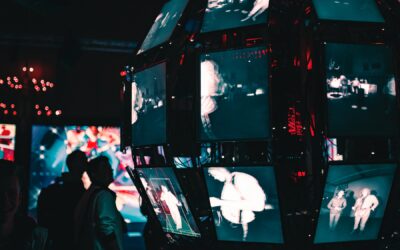Interest in augmented reality (AR) has exploded as software designers and entrepreneurs explore its business relevance. To date, AR has played a role in workforce enablement, customer experience and interaction as well as a host of behind the scenes business operations. Augmented reality, as an emerging technology, has shown tremendous promise for change in the business landscape.
Each industry has its own relationship with augmented reality. The tech industry, for example, is particularly interested in the future of AR. Tech industry forecasters predict the market worth for AR to reach $50 billion by 2024. Outside of the tech sector, which markets will embrace this technology? Industry experts and research analysts say revenues will be split across a range of sectors from education, healthcare and retail to finance, gaming and construction, to name but a few.
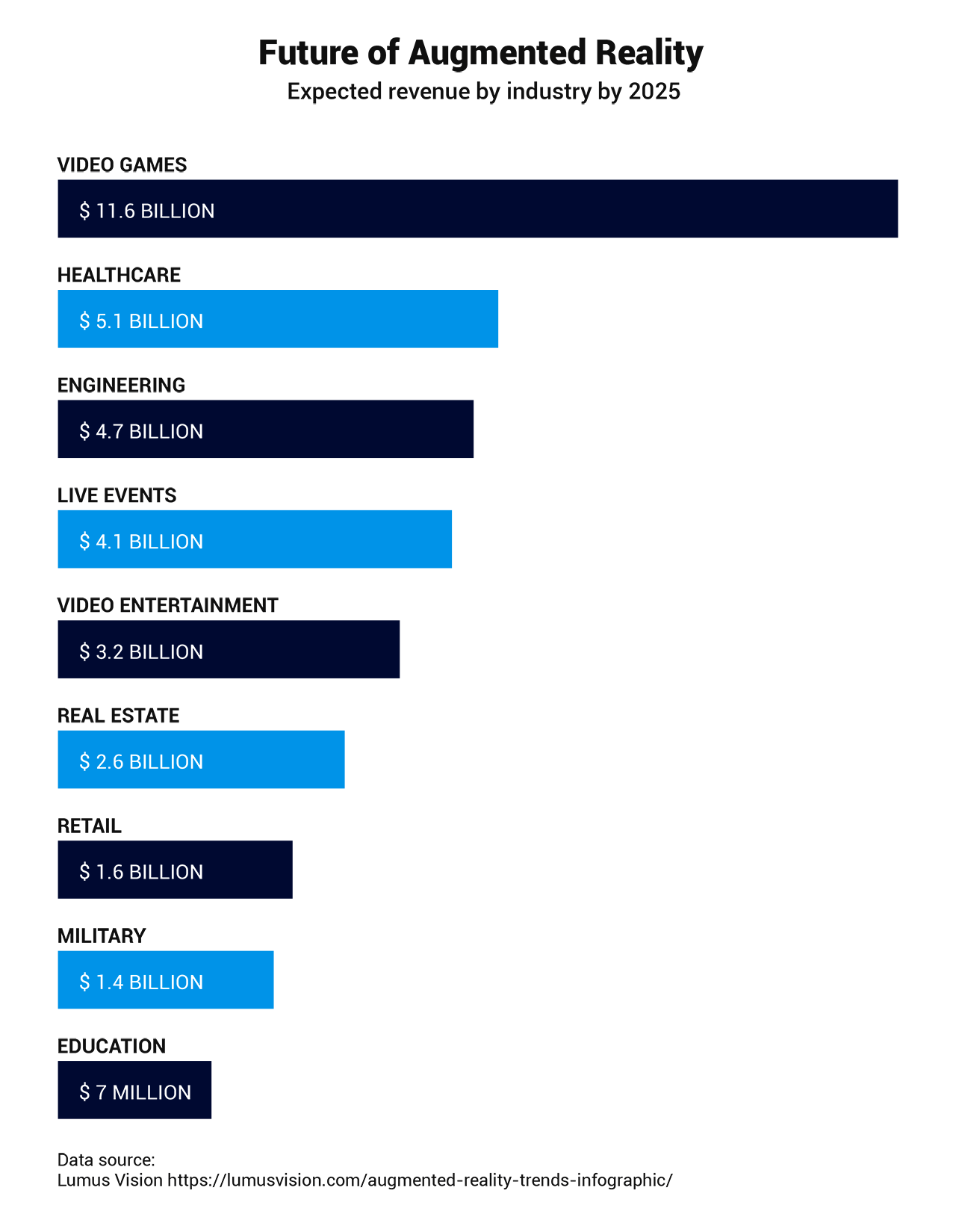
(AR expected revenue by industry. Image: MobiDev)
Augmented reality may have its roots in fun and games like Instagram filters and Pokemon Go but AR is maturing into an imperative business tool. Today, essentially every industry is at the very least, waking up to the potential of augmented reality. Its capacity to provide business solutions that were unthinkable just a few years ago, makes this a very exciting and revolutionary time.
Not all businesses are as tech-savvy as each other. Some are yet to tap into the power and potential of AR, but it will be the early entrants that will be sure to experience the benefits and jump far ahead of the competition.
What is AR and what makes it so useful today?
Augmented reality is essentially an enhanced version of the real and physical world that is achieved through the use of digital visual elements and sensory stimuli delivered through a screen. It’s an interactive experience where the real-life objects are augmented by computer-generated content to allow users to interact with the real environment using digital content.
When used well, this emerging technology can generate more customer loyalty and commitment to brands. AR technology enables users to interact with people, things, places and services; simply by walking around a store, office, outdoors, or at home with a mobile device in their hands.
Already the possibilities are endless, and developers are just at the tip of the iceberg in uncovering ARs’ full potential. But what makes AR so effective in the 21st century? A combination of consumer trends and digitally-centric behaviour has driven the need for businesses to apply AR across their operations.
The ubiquity of mobile devices and AR
Not only have smartphones become increasingly depended on in everyday life, but they’re also vital in the digital modern age. There were 2.87 billion smartphone users worldwide in 2020 (Statista). Since AR is predominantly delivered through smartphones and mobile devices, it’s constantly accessible to everyone. This makes the digital age the perfect setting for AR to thrive.
AR has taken on a scale, flexibility, mobility and ubiquity of its own and has driven an explosion of new use cases across businesses. As the technology becomes more ubiquitous, AR is set to become less of the novelty we currently recognize it to be, and form a more integral part of consumers’ everyday lives – just as smartphones did.
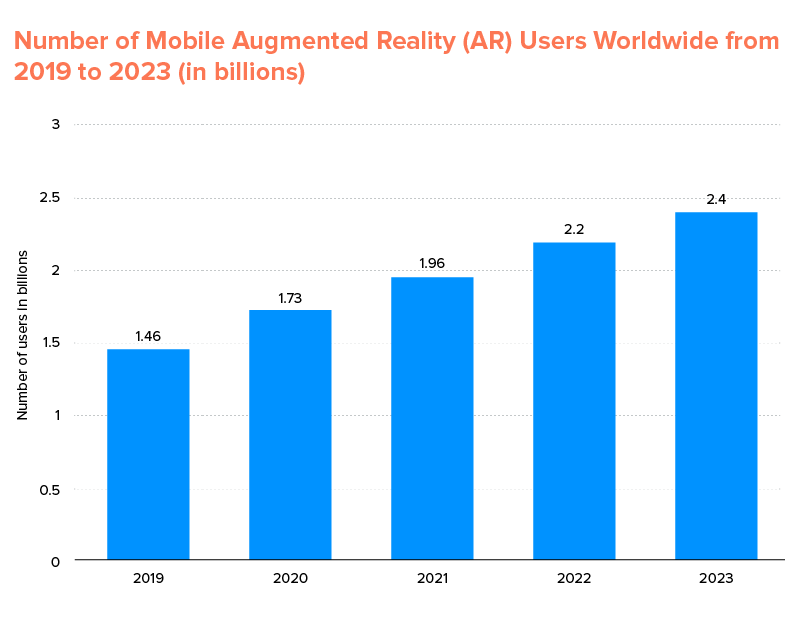
(AR mobile users worldwide 2019 – 2023. Image: Appinventiv)
It has been proven by Houzz that AR can indeed increase the sales conversion rate by 11x. From increasing sales to generating brand awareness, AR offers more than just a possibility or chance; but is likely to change the way businesses work. It’s predicted that when Apple launches its smartphone-tethered smartglasses, hardware sales could become ARs’ second-largest income stream after e-Commerce.
Maturity of AR
Applications of augmented reality (AR) in business dates back to the 1960s. Despite it not having all the bells and whistles we’ve come to expect today, it had to have started somewhere. Since 1968 and Ivan Sunderland’s first head-mounted display, AR has grown considerably over the past 20 years.
Evolution of augmented reality

(Development timeline of AR 1968 – 2020. Image: AppVenturez)
Two main components make up augmented reality technology: the software, which is the apps and algorithms and the hardware, through which the digital content is delivered. As each becomes more advanced, sophisticated and competitive; the costs associated with implementing AR into business operations fall well within the budgets of startups, SMEs and of course larger-scale enterprises. Not to mention the increased accessibility of AR to consumers.
Trends changing consumer expectations
The age-old principles of customer service are timeless. Consumers will never want businesses to stop being friendly, helpful, efficient, and reliable, but the trends that drive consumers’ spending habits are constantly changing. As technology develops, consumer expectations have gone through the roof. They want immediate, personalised, and engaging service 24/7.
The rise of self-service has led to a generation of customers who are willing, happy, and able to help themselves. From self-checkouts to finding the information they need – consumers have all they need to solve their problems themselves. Augmented reality has the capacity to enhance the consumer experience when it comes to navigating their way through streets, finding product information, and engaging with the brands they love.
Living in an age where everyone has a smartphone in their back pocket, connecting them to every aspect of their lives; consumers expect to be able to access everything they need from their phones. If the capacity for a user to scan a barcode using their camera to generate interactive content exists, consumers will demand to have access to it.
In short, consumers want to be involved in and taken along the technological journey. This is precisely why, AR in business simply cannot exist without sharing it with consumers, who will inevitably share it with their friends.
Augmented reality in business
Technological advancements have always been implemented in business operations and strategies. From computers, phones, printers and the internet; they allow businesses easy and efficient access to information and a means to share it. Augmented reality is next in the pipeline to transform the way we work and consume.
Companies that want to stay competitive should at the very least take time to consider where augmented reality could fit into their business. Whether that be in their marketing strategy, sales funnel, financial operations or data management, the applications of AR are vast and it’s only going to become more important as time goes on.
In general, there are two main ways a business should think about implementing AR into their organisation. First, they should consider its potential for internal use – including workforce enablement, communications, product design and manufacturing. And second, the commercial applicability for consumers of AR. Let’s take a look at some examples of how businesses in different industries are utilising AR.
Applications of AR in different industries
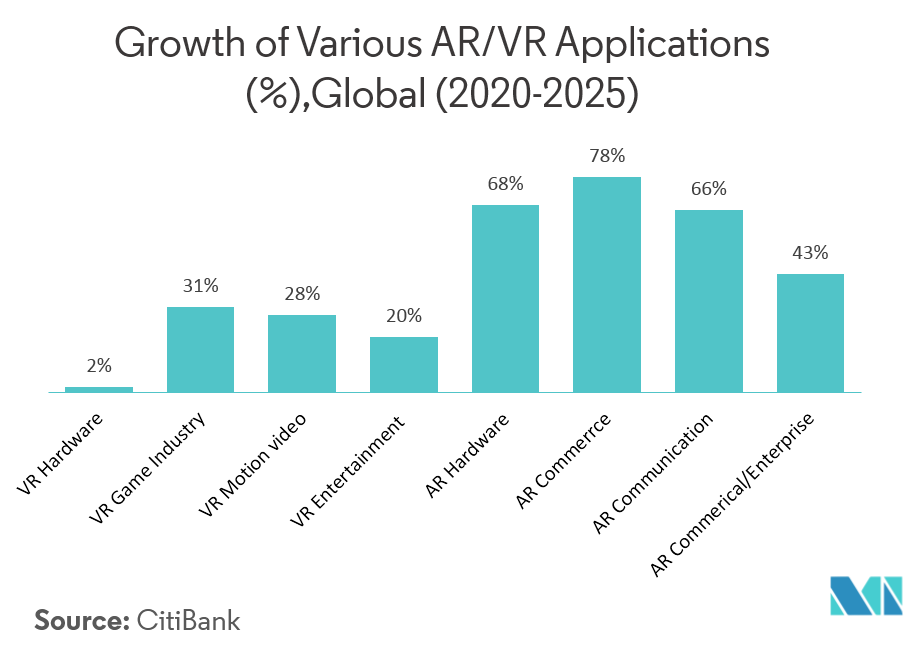
(Expected growth rate of various AR and VR applications. Image: Mordor Intelligence)
The growth and development of various AR applications in the industry are expected to trickle down, and feed into industrial use cases. Let’s take a look at how businesses in different industries can utilise the promise of AR across their operations.
Manufacturing and construction
AR saves time and money in manufacturing like no other industry. Within this sector, there is no room for mistakes in the development process. A minor error can quickly become the reason for rebuilding, remodelling, and remaking. AR is the ultimate solution for easy spotting of manufacturing errors and has been put to good use within the industry.
Augmented reality technology has the potential to digitize the process of product development, from the conception of an idea, through to prototyping in 3D and execution of manufacturing. Decision-makers and key stakeholders can view the same computer-generated data, manipulate it, and collaborate remotely on potential designs. Not only does this increase the speed of the process, but also makes it more efficient. The overall experience of the project is enhanced and becomes more profitable.
Augmented reality devices are more promising than those of virtual reality (VR) since it requires no obstructive and intrusive headsets for use. AR enables users to move around seamlessly and naturally to gain an uninterrupted 306-degree appreciation for the surroundings of an object or building.
The use cases of VR in manufacturing are vast. It can be used to measure a variety of changes – without having to make costly and timely changes in real life, identify unsafe working conditions, and even envisage a finished product. Additional content such as graphs, imagery, and text can be overlayed onto the user’s screen to provide more information. This could be product features for client views or training guides and instructions for employees.
Safety is a key issue in manufacturing is complemented by the use of AR. A user can even view a piece of equipment through their device and see its real-time temperature, disclosing that the object is hot and unsafe to touch, for example. Further, on-site staff can see everything that’s happening around them – like the location of coworkers, faulty equipment, and the restricted areas in a factory or warehouse.
When AR is implemented correctly, it promises a broad spectrum of business benefits in the manufacturing industry. Employees can remain well-informed and highly trained at all times, protected in unsafe environments without wasting company resources, and efficiencies are improved.
Education
It has been proven that interactive learning improves the engagement of learners and students across all settings. AR is improving learning in the education sector in two main ways: by engaging users and by making concepts interactive. AR and gamification provide the most user-friendly tools in a learning environment for both teachers and students.
Empowering students to learn beyond the constraints of textbook materials helps to satisfy curiosity as well as strengthen information retention. Today, the education sector is exploring evermore AR solutions for effective learning from companies like Mesmerise.
From history and palaeontology to chemistry and physics, AR can drive better learning results. Dinosaur 4D+ is an AR app that comes with a set of flashcards of which users can scan to see dinosaurs in 3D. Students can rotate them, zoom in and out and watch them roar whilst learning more information about each dinosaur.
In the chemistry classroom, Elements 4D uses AR to make chemistry more engaging in a safe setting. The app asks students to make paper cups from special element blocks. Once scanned through the student’s camera, they can see visual representations of chemical elements, along with more information. Students can even bring elements together to see how they react in real life.
Medical students are particularly well-placed in light of this emerging technology. Those training in life-saving situations can improve their skills and knowledge by taking advantage of AR to practice surgeries on virtual patients, and find detailed illustrations of human anatomy.
The Human Anatomy Atlas app allows students to explore the human body by allowing them to rotate and interact with them. The app provides more than 10,000 anatomical models and information in seven languages.
Marketing
Long gone are the days of billboards and static magazine ads. AR marketing is set to become the new and expected way of delivering content to your target audience. AR ultimately brings to life formerly static marketing mediums and enables marketers to incorporate 3D animations, video, and targeted information into billboards, storefronts, magazines, and even t-shirts.
AR marketing brings a truly interactive and exciting experience to target audiences and can be used in an array of ways. One of the most recent use cases for AR in this setting has been taking branding materials to the next level by adding virtual content.
Users can scan printed materials with their smart, camera-enabled devices to access features that give them information, entertainment and contact details. It encourages customers to actively interact with brands by giving them the tools they need to reach out.
For example, AR-enabled branding materials allow users to scan a barcode, wherever they are, to bring up a video highlighting more information about the product or service. The dynamic element of this engagement helps to prompt the user to take actions – whatever you might want that to be. Alternatively, business cards can use AR to digitize the information on the card. By scanning the card, a user can be presented with contact details as well as live links for easy contact options.
AR can also be used as part of an indirect marketing campaign. The sheer novelty and unexpected fun of the technology could be enough to get people talking about your brand. If used properly, the branded content can be shared across social media, resulting in a significant buzz around the brand.
Since AR is a relatively new technology – especially in the marketing industry – well-designed, meaningful and engaging AR content will generate a lasting impression of the experience. This kind of exposure and customer fascination can pay lasting dividends.
Consider Pepsi’s AR campaign of which generated a lot of noise around the brand. Pepsi encouraged people to use their smartphone cameras to activate the AR experience at a London bus stop. Users were treated to seeing tigers, UFOs, and robots running around London within the AR vista. It certainly got people talking and ultimately thinking about Pepsi.
Businesses have continued to follow suit with similar AR campaigns. And in a highly saturated and competitive market, an AR campaign could be the differentiator that allows a brand to stand out and generate sustained discussion.
Fashion and retail
Since the beginning of time, shoppers in need would have to leave their homes to find what they want before purchasing, taking it home, and using it. Whilst the internet and online shopping have been revolutionary in their own rights, AR is transforming the way we make purchasing decisions remotely and in-stores.
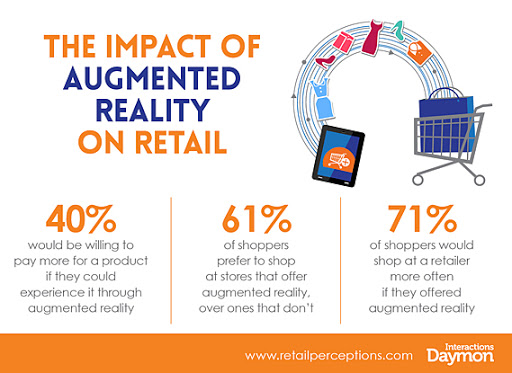
(Effects of AR-retail on consumer perception. Image: InteractionsDaymon)
AR-enabled apps in the retail and fashion industries can go as far as displaying additional information on product descriptions, to showing the user precisely what the item could look like once it belongs to them. This powerful tool helps to drive sales, minimize returns and improves the overall user experience.
Traditionally, one of the hardest aspects of any sales role or process is to convince a customer that they should make the purchase. Now you don’t have to since customers can see for themselves.
There have already been a few retail and fashion brands that have tried their hand at AR-enabled consumer tools. Those first on the scene were companies like GAPInc. who developed an AR space Dressing Room. It allowed users to customize an avatar based on their body type and dress them accordingly.
ASOS, a British online fashion retailer recently launched an experimental new AR feature on its app called Virtual Catwalk. The feature gives users a brand new way of viewing its product in a real-life environment. Meanwhile, John Lewis has just jumped on the AR bandwagon with its Visualise Your Space experience, which enables customers to view products in their home before they commit to buying.
Blurring the lines between digital content and the real world has reimagined the shopping process.
Travel and tourism
More so than ever, people are being exposed to digital content of faraway lands and dream destinations. Travel bloggers and influencers have dominated the space over the past 10 years through social media channels. Today, travel companies and tourist resorts have taken it upon themselves to create interactive, transportive AR visual experiences.
Users can take a 360-degree tour of a vacation destination on their phones. From booking hotel rooms to planning events and upgrading tickets; AR is here to make travelling seamless and memorable.
AR experiences in this space have the potential to empower travellers to plan and anticipate visits to new places before even leaving their homes. It adds to the search experience by offering engaging and interactive content. Pioneering mobile apps have simplified holiday planning and booking.
Travel specialists in the industry have forecasted that the power of AR will transform the industry, boost profitability and guest experience. After all, when you visit a new city, there’s only so much a traditional tour-guide can offer. AR can act as a real-life tour guide with infinite information and recommendations in real-time.
As the camera captures the landscape, the mobile AR app can mark a place of significance, provide navigation details to get there and give insightful tourist information on the region. Marker-based AR technology provides the user with detailed information about a particular thing in the camera’s field of vision. The travel company, Thomas Cook, offers digital content with a marker-based AR app in addition to printed material.
Food and hospitality
Across industries, AR bridges the gap between consumer, product, and product content. But what about when the product revolves predominantly around the sense of taste? Using AR in menus gives the dining experience an extra dimension when it comes to elevating eating out (or in).
The added virtual element shows customers not only how the dish looks, but a chance to experience the textures, colours, and origins before it’s even cooked. What’s more, AR can be an incredibly efficient way for consumers to get detailed information on ingredients and nutritional value. From a safety standpoint – this is particularly useful for people with food intolerances. From a culinary perspective, this could encourage chefs to experiment with new and exciting ingredients to create dishes more in line with what consumers want.
Beyond this, the rules of AR-based marketing apply particularly well in the food industry. For example, Patron, a tequila-maker, developed an AR-based campaign to give iOS users an AR experience of drinking different types of tequila with a virtual bartender explaining the origins and tastes of each one.
In the age of live-work-and-play-at-home, ordering food has become increasingly popular. AR applied in this context gives users a more interactive experience instead of just ordering something they’ve read about. The entire process of ordering food is enhanced and clearly provides exciting prospects for companies like Uber Eats, Deliveroo, and Globo, for example
In a different area of the same industry, packaging can be enhanced and made more sustainable by implementing AR. Rather than use ink, plastic and bright catchy colours on bags and boxes, a plain paper bag with an interactive barcode could do the same trick. Diners simply scan the code for interactive content to complement their meal.
AR can also allow companies from completely different industries to collaborate with each other seamlessly. For example, a brand of cereal in the shape of Disney princesses that use AR to show a film trailer would connect the food industry with the movie industry.
When it comes to the hotel and hospitality industry, AR can significantly enhance the guest experience. Hotels are already beginning to utilise AR to enable guests to scan different sections of the hotel for more information on its history, or to scan a painting in a hotel room for more details on the artist and its significance.
Enterprise
Entrepreneurs, business owners, and stakeholders can now connect with clients face to face, join an AR-based meeting remotely and collaborate efficiently using AR. The potential of AR in this space is already being explored by a host of organisations that need seamless communication across departments.
For example, AR enables sales and marketing teams to ‘test drive’ any product or customer experience, gather data and feedback, and work on improvement. Whilst collaboration within the business is key, collaboration with customers is the answer to growth. Allowing customers in on product development through AR is a good way to engage them, get feedback and show them that you value their wants and needs.
As we know, the current exploration of AR in business is in its very preliminary stages. The emerging technology is still pathing the way for a new era in business. From improving customer-brand relations to accommodating the business and consumer trends; AR continues to grow rapidly. Given the market is forecast to cross $117.4 billion by 2022; there are obvious reasons for your business to invest in AR app development.






